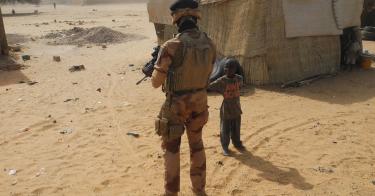The Sahel is fast becoming the world’s newest terror hot spot.
A vast transition zone between Africa’s Saharan north and savanna south, the region holds a toxic stew of al Qaeda- and Islamic State-affiliated groups that are expanding their operations and becoming deadlier, even as communal violence surges.
Sahelian governments and militaries are generally weak and overmatched, and international interventions have failed to curb the bloodshed.
If swaths of this critical region slip further into chaos — or worse, under Islamist control — then the U.S. and its allies will suffer the consequences into the foreseeable future.
The spike in Sahelian violence is stark. Reported Islamist-linked violent acts and related fatalities have doubled every year since 2016. In the past five months in Burkina Faso, civilian fatalities have risen more than 7,000% compared with the same period the previous year. At least 10 Islamist terrorist groups now operate in the West African Sahel, where only a short time ago al Qaeda in the Islamic Maghreb was the sole Islamist predator.
Libya’s meltdown after the 2011 overthrow of dictator Moammar Gadhafi accelerated the process of instability. At that time, hardened mercenaries from the Tuareg tribe, once in the employ of Gadhafi, returned home — especially to northern Mali — and supercharged the Islamist terrorist groups and Tuareg secessionist movements there.
A 2013 French military intervention temporarily repelled the groups but could not kill them. The groups metastasized and spilled over Mali’s borders, sometimes plugging into the many tribal and organized criminal networks crisscrossing the region.
The weak states governing the region were quickly overwhelmed, and their failure to deliver adequate security and services to their populations is now haunting them. Most have failed to give their people a reason to refuse support for or submission to the terrorist groups, allowing some of them to burrow into local communities.
The Sahel is a highway, and the world cannot afford to let terrorist organizations set up toll booths. South American drugs supplying Europe flow through West Africa. Major human trafficking and smuggling routes twist through the Sahel. If the terrorist groups that already profit from these trades carve out even more space to operate, they will grow wealthier and more capable, while hopes of suppressing the illicit flow of drugs and people will grow dimmer.
Meanwhile, the terrorist violence is tearing at the brittle social fabric of Sahelian countries by exacerbating old sectarian divisions. A recent terrorist attack in Burkina Faso targeted a church for the first time, potentially an ominous prelude to a larger campaign against Christians that could inflame interfaith relations and boost Islamist terrorists’ narrative about a civilizational clash between faiths.
Clashes between tribes competing over resources are growing. Members of the Fulani, a huge tribe spread across 21 countries, are involved in conflicts in various Sahel countries. As these battles grow bloodier, terrorist groups may find Fulani ever riper for recruitment. Abu Walid al Sahrawi, leader of the Islamic State in the Greater Sahara (ISGS), recruited dozens of Fulani for his previous terrorist organization, Movement for Oneness and Jihad in West Africa, known by its French acronym MUJAO. Doundou Chefou, a senior Fulani member of ISGS, led the 2017 ambush that killed four U.S. special operators in Niger.
There are no easy solutions in the Sahel. The U.S. will have to coordinate as closely as possible with its various allies, particularly from Europe, who are battling the upsurge in Sahel violence.
The U.N. Security Council should revamp the besieged U.N. peacekeeping operation in Mali into a war-fighting operation, strip it of any superfluous appendages, and endow it with clear and achievable goals that support a larger, integrated strategy. The international community engaged in the Sahel also must incentivize the region’s inadequate governments to perform better — and hold them accountable when they do not.
We already have seen what happens when the world allows Islamist terrorist groups safe harbor in remote, poorly governed areas where they can amass tremendous resources from criminal activity while honing their deadly skills and plotting attacks. The world cannot afford to let the Sahel become the next Afghanistan.
This piece originally appeared in The Washington Times



